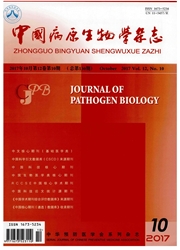

 中文摘要:
中文摘要:
目的分析南昌市2009-2013年重症手足口病发病情况,了解手足口病重症病例的基本特征。方法由"疾病监测信息报告管理系统"导出重症手足口病的数据,采取描述性与分析性流行病学相结合的方法进行统计描述。结果 2009-2013年南昌市共报告重症手足口病病例302例,男女性别比为2.21︰1,〈3岁幼儿265例,占重症病例总数的87.75%。发病高峰为每年的16-27周;病例在家庭居住地的分布上差异有统计学意义(χ2=21.66,P=0.001)。手足口病病毒阳性患者中,EV71型占75.11%。病毒型别在不同年份间的分布差异有统计学意义(χ2=23.21,P=0.026),2013年较前四年肠道病毒未分型有升高趋势。死亡病例占所有重症手足口病病例的6.29%,主要来自农村(84.21%),以手足口病病毒EV71型为主(84.21%)。结论应持续监测手足口病病毒在人群中的变异情况,并进一步提高医疗机构重症手足口病识别与诊疗能力,最大限度提高重症手足口病患儿救治成功率。
 英文摘要:
英文摘要:
Objective To study the epidemiological characteristics of cases of severe hand,foot,and mouth disease(SHFMD)in Nanchang from 2009 to 2011. Methods Data on cases of SHFMD were downloaded from China Information System for Disease Control and Prevention.SHFMD was detected in throat swabs with a real-time reverse transcription polymerase chain reaction.Descriptive and analytic epidemiology were used to analyze the epidemiological characteristics of SHFMD. Results In total,302 cases of SHFMD were reported,and the male-female ratio was 2.07︰1.Most patients were under 3years of age(265/302,87.75%).The peak in incidence varied from week 16 to 27every year,while a relatively lower autumn peak was evident in 2011.There were statistically significant differences in the distribution of places where patients lived(χ2=21.66,P=0.001).Of all the laboratory confirmed cases of SHFMD,75.11%were type EV71.The distribution of virus types differed significantly(χ2=23.21,P=0.026)during the five years studied,and the other types of enterovirus responsible for HFMD increased in comparison to the previous four years.SHFMD had a mortality rate of 6.29%.Of the deaths,most involved patients from rural areas(84.21%)and infection with EV71(84.21%).Conclusion Variation in the enterovirus responsible for HFMD should be continually monitored,and the ability to recognize and diagnose the disease should be improved to increase the success rate of treatment at medical facilities.
 同期刊论文项目
同期刊论文项目
 同项目期刊论文
同项目期刊论文
 期刊信息
期刊信息
